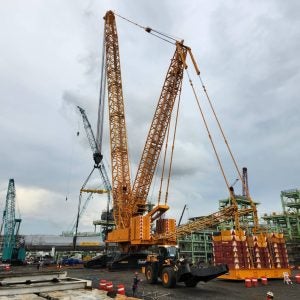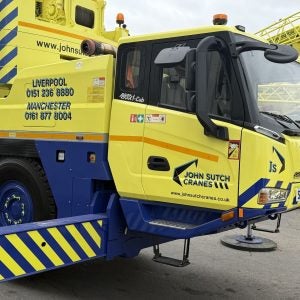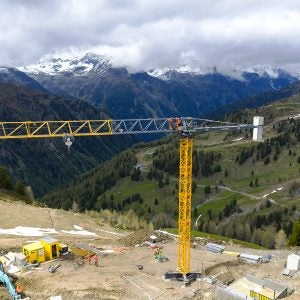Our cover story this month is on the completion of construction of the New Safe Confinement (NSC) at Chernobyl. Given the global risks posed by the crumbling reactor, the unique challenges of the job, and the sheer scope of the project, I think it is fair to say this is a lifting and moving job of world historical significance.
The reactor itself, and the concrete sarcophagus that was initally and hastily poured over it, are still emitting fatal levels of radiation.
The NSC was designed to safely enclose the reactor, and to allow a one-off overhead crane system from PaR to disassemble the reactor.
Designing the NSC and planning how to build it in this radioactive environment has been a decades-long process. Mobile crane operators on the project needed to work from specially-designed lead-lined cabs; tower cranes, closer to the reactor, were operated instead by remote control from concrete bunkers.
As the NSC could not be built in place, it needed to be assembled in pieces, joined together, and then skidded into position.
A success like this shows how, on a single job, even the most challenging risks can be reduced to an acceptable level with careful planning. Our second (partly) historical feature this month though shows how hard it can be to predict broader market conditions.
Over the last decade or two, Stuart Anderson explains, Chinese manufacturers have been developing global products and looking to build their export businesses; distributors have been working to support their entry into new markets. In the more technologically focussed and tightly regulated markets, these plans have borne little fruit.
Part of the failure there has been a lack of knowledge. Chinese manufacturers did not seem to have a clear understanding of what customers would expect in terms of consistent parts and support; their local distributors did not really know what to expect from the cranes they were bringing into the country.
Next month, Stuart will be looking in detail at the countries where Chinese manufacturers have seen success. There are some easy to spot patterns in these successes. However, there are also some wild fluctuations in sales numbers, illustrating the continuing challenges of predicting global demand.
Our second markets piece this month, by Paola De Pascali, looks at the state of the market for new tower crane sales. Paola highlights one example of a Chinese manufacturer, Zoomlion, entering another developed market, the USA, in collaboration with local distributor P&J Arcomet. That bold move aside, consistently, the interviewees Paola spoke to indicated that most demand is for higher capacity cranes.
I don't think that shows that there is a highly disproportional number of jobs currently for bigger tower cranes. Rather, the overall tower crane market remains saturated, and it is only at the higher end where customers are pushing the limits of what can be lifted, and asking for newer, bigger cranes.
When that general demand will return remains an open question. As we look forward to ConExpo, many of us will be reminded of the highs and lows of trying to make an investment in an inherently unpredictable market.
The global construction sector might not be quite as unpredictable as the throw of a dice, but it is still very hard to forecast.
In the ten years I've been on this magazine, the construction sector trade show cycle has concentrated on two big shows, Bauma and ConExpo. I'm expecting some surprises in Las Vegas this year, but based on the previews we have in this issue, I think it is fair to say that this year's US show will be overshadowed by its German rival: many of the crane companies taking part are promising the first North American showing of their newest cranes, rather than something entirely new.
It is very much unclear to me whether this is because the ongoing poor performance of the market has stifled innovation, or because the big manufacturers are timing their development cycles to coincide with Bauma alone. It may also be, as we saw with many launches in recent years, that they see more value in in-house launch events.
Will North Editor
wnorth@cranestodaymagazine.com






